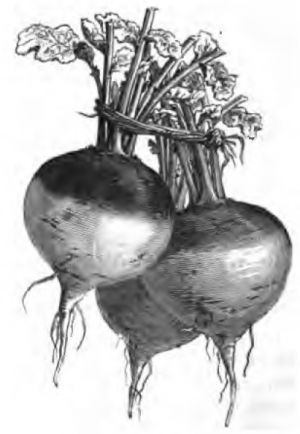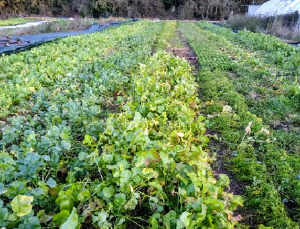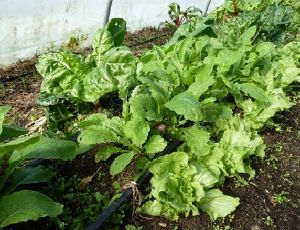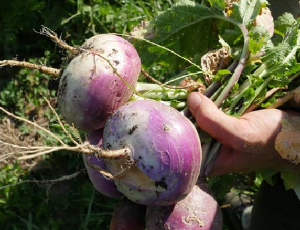Brassica rapa

Turnips are often sown directly, mulched and fairly dense. The early crop is quite interesting, sold in bunches, it allows you to fill early spring. As with radishes you can have fun exploring varieties to vary tastes.
Preparing the soil
Covering the bed with a tarpaulin before growing limits weed during cultivation. The plants are placed on a weeded bed. An application of compost or 5 cm of compost orshredded green waste can make planting and sowing easier. and sowing. Turnips are sensitive to bolting at the end of winter or after stress, so stagger sowing, choosing the right varieties for the season is essential.

Planting
For planting, the plants are prepared in anursery. seedlings are prepared in a nursery, and sown in plugs or trays with 3 to 4 seeds per hole. Planting on 5 cm of compost for better growth. Mulching can be organic : straw or shredded material, or inorganic : woven tarpaulin or silage. The plants are transplanted manually at the 3-4 leaf stage at a spacing of 3 x 15 cm to 5 x 15 cm.
Planting conditions depend on the expected production
density will be higher if the crop is not harvested in a single
in a single pass and will be lower if production is staggered
with uniform sizes.
Tip : Test varieties to vary taste and colour. However, to ensure classic production, consumers have their own habits.

Monitoring the crop
Like radishes, turnips have the advantage of competition with weeds, thus limiting weed cover, even on bare soil. Weeding at the start of the crop the crop can counteract early weediness. In the case of the tarpaulin and rootball system, weeding is rarely necessary. rarely necessary.
Irrigation
Turnips are irrigated using dri p or sprinkler systems. Like radishes, turnips require a lot of water, especially to avoid a stronger taste in the mouth.
Harvest

Harvesting of early turnips begins when the bunches into neat, uniform bunches. For bulk turnips it's up to you, making sure you don't get wormy or overly large or too large bunches.
Storage
Like other root vegetables, turnips can be stored in the :
- In the field + installation of P17 (beware of the risk of frost, field mice, etc., which can lead to major losses)
- In sand trays
- In cellars in paloxes/crates
- In in-ground or above-ground silos (in nets or micro-perforated bags of compost)
- In cold storage. Storage temperature : Ideally 6°C, relative humidity 90-95%.
Pests and diseases
- The two main pests of turnips are flea beetles and cabbage flies. Installing a fine anti-insect net (Biotex type) from spring onwards will help to limit pest attacks (cabbage maggot, flea beetle, cabbageworm).
- Keep an eye on fungal diseases from December to March and prevent them by aerating the crop and favouring watering on sunny mornings.
Adapting to the soil and climate
By staggering turnip production over several sowings, you can to harvest only young plants. The turnips can be harvested all year round, adapting the itinerary to the to the season and climatic conditions, thanks to shelters wintering sails and choosing appropriate varieties.
Possible ITK variations
For direct seeding, it is best to have a fairly thin seedbed, laid with :
- Spreading compost (minimum 5 cm). Here, fine, even compost prevents weeds from emerging and also acts as a seedbed. If a seed drill is used, remove any pieces of wood from the compost so that the drill does not "jam". Rolling the seed to press it into the soil can encourage germination.
Take care with the density of the seed to avoid thinning out to guarantee size. After emergence, mulching between the rows between the rows to limit weed growth.
Sowing is only moderately successful in spring, as conditions are not always right. It is easier at the end of for autumn turnips.
Sources
- This page is based on the guide Introduction au maraîchage sol vivant from MSV Normandie.
